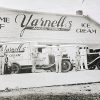calsfoundation@cals.org
Cattle Drives
Arkansas was the source for many cattle drives westward following the California gold rush, and some later cattle drives cut through Arkansas for points northward. Though a more minor player in the overland transportation of cattle than neighboring Texas, Arkansas was nonetheless significantly affected by these cattle drives.
When some Cherokee migrated into Arkansas in the late eighteenth and early nineteenth centuries, they drove cattle with them. However, the first major cattle drives organized in Arkansas took place following the discovery of gold in California in 1848, when many Arkansans drove their cattle west in order to meet the increasing need for supplies of the numerous people settling there. As historian J. H. Atkinson notes, “A cow that sold for fifty dollars in the gold fields could be purchased back in Arkansas for usually five dollars,” given the surplus of cattle in Arkansas. These cattle drives departed the state for points west from Fort Smith (Sebastian County), a city that boomed as more and more western adventurers equipped themselves there. James Miles Morse of Conway County reportedly made two such cattle drives west following the Arkansas River. John Kirkbride Potts of Pope County, later the founder of Pottsville, made at least two cattle drives west, and profited enough that he was able to build a grand house for his family. Another known cattle drive was organized by Thomas Jefferson Linton of Pope County. Both Linton and Potts reported the necessity of grazing their cattle in California for some time so as to fatten them before sale.
Some immigrants west followed the route of the Butterfield Overland Mail Company, which left Fort Smith in a southwesterly direction, cutting through Indian Territory (present-day Oklahoma), Texas, and what would later become the states of New Mexico and Arizona, before arriving in San Francisco, California. Two known drovers who used this route were Samuel Mayes and John Hackett, both of whom had lived in Arkansas before moving their herds to Indian Territory. A more popular route was the Cherokee Trail, which largely followed the course of the Arkansas River from Fort Smith northwest through Indian Territory, Kansas, and present-day Colorado; there, it cut northward in the vicinity of what is now Pueblo until it entered the present-day state of Wyoming, after which it turned west again, running parallel to the southern border, cutting across Utah and Nevada before finally entering California. Alexander Fancher drove 400 head of cattle to California in 1854 to a ranch he and his brother had established on an earlier trip. In 1857, he helped to lead another party heading west, but this time they crossed Utah in a southeasterly direction. The party was attacked by Mormons in what has become known as the Mountain Meadows Massacre. Most of the travelers were killed, and the cattle were stolen.
The Civil War nearly destroyed the cattle industry in Arkansas, but Texas escaped relatively unharmed, with returning soldiers finding that the longhorn cattle grazing on the open range had multiplied to somewhere between five and six million head. Before the war, one of the most popular cattle trails, the Shawnee Trail, went north through Oklahoma and then east into Missouri to Kansas City, Sedalia, or St. Louis. As the railroad expanded westward, so were cattle driven in a more westerly direction, though a few cattle drives did cut through the state of Arkansas. In 1866, Ohio livestock buyer Upton Bushnell arranged for a herd to be driven to Chicago, Illinois. From Fort Smith, the herd cut north to the Prairie Grove (Washington County) area and then east through Madison and Carroll counties before proceeding north into Missouri. According to industry historian C. J. Brown, Bushnell’s herd accounts for the appearance of Texas tick fever in Arkansas.
Cattle drives began to diminish following the Civil War, as railroad expansion in Arkansas and points west offered alternative means of transporting livestock, especially once specialized stock cars were introduced in the 1880s, making it easier to transport live animals. The contemporaneous introduction of the refrigerator car also meant that animals could be processed closer to where they were raised.
For additional information:
Atkinson, J. H. “Cattle Drives from Arkansas to California Prior to the Civil War.” Arkansas Historical Quarterly 28 (Autumn 1969): 275–281.
Brown, C. J. Cattle on a Thousand Hills: A History of the Cattle Industry in Arkansas. Fayetteville: University of Arkansas Press, 1996.
Denton, I. Old Brands and Lost Trails: Arkansas and the Great Cattle Drives. Fayetteville: University of Arkansas Press, 1992.
Holsted, David. “Museum Musings: When the Texas Longhorns Came to Boone County.” Harrison Daily Times, June 28, 2018. Online at http://harrisondaily.com/news/museum-musings-when-the-texas-longhorns-came-to-boone-county/article_9a94f1be-7a3e-11e8-a3f8-8f72b1e4942b.html (accessed March 8, 2022).
Staff of the CALS Encyclopedia of Arkansas





Comments
No comments on this entry yet.